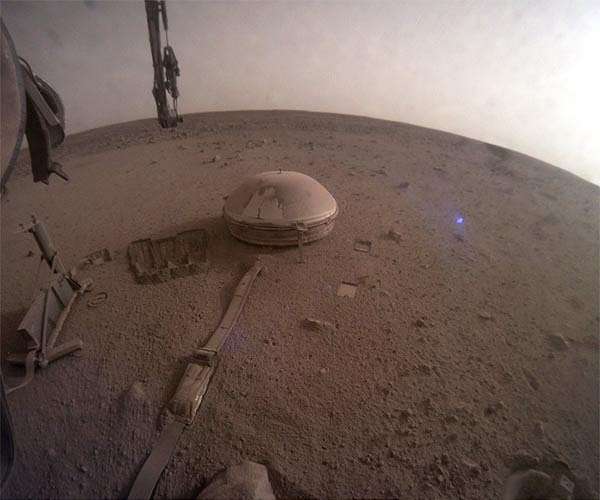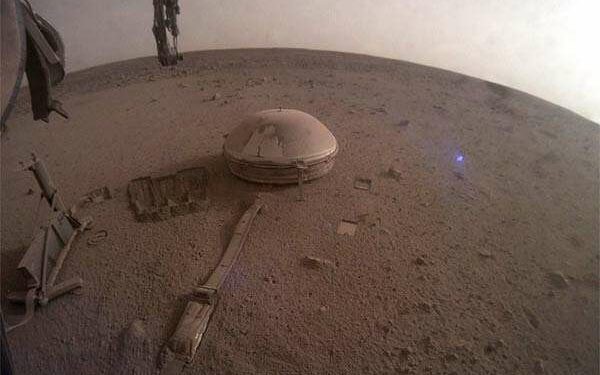
InSight data reveals Mars hit by more meteoroids than previously estimated
by Clarence Oxford
Los Angeles CA (SPX) Jul 01, 2024
NASA’s Mars InSight Lander may have completed its mission, but data from the robotic explorer continues to reveal new seismic discoveries. Recent findings suggest that Mars experiences meteoroid impacts more frequently than previously believed.
A study led by a researcher from Brown University indicates that Mars is bombarded by space rocks at rates two to ten times higher than earlier estimates, depending on meteoroid size. The study, published in Science Advances, utilized data from InSight to reach these conclusions.
“It’s possible Mars is more geologically active than we thought, which holds implications for the age and evolution of the planet’s surface,” explained Ingrid Daubar, an associate professor of Earth, environmental, and planetary sciences at Brown. “Our results are based on a small number of examples available to us, but the estimate of the current impact rate suggests the planet is getting hit much more frequently than we can see using imaging alone.”
Using InSight’s sensitive seismometer, the team identified eight new impact craters from meteoroids that had not been previously detected from orbit. These findings challenge current understandings of how often meteoroids strike Mars and suggest the need to revise existing Martian cratering models to reflect higher impact rates, particularly from smaller meteoroids. This new data could reshape understandings of the Martian surface and the impact history of other planets.
“This is going to require us to rethink some of the models the science community uses to estimate the age of planetary surfaces throughout the entire solar system,” Daubar said.
The researchers found six craters near InSight’s landing site and identified two more significant impacts from the data, which are the largest ever detected by scientists. The larger impacts, each creating a crater the size of a football field, occurred just 97 days apart, highlighting the frequency of such events.
“This size impact, we would expect to happen maybe once every couple of decades, maybe even once in a lifetime, but here we have two of them that are just over 90 days apart,” Daubar commented. “It could just be a crazy coincidence, but there’s a really, really small likelihood that it’s just coincidence. What’s more likely is that either the two big impacts are related, or the impact rate is a lot higher for Mars than what we thought it was.”
NASA’s InSight mission, active from November 2018 to December 2022, aimed to measure the planet’s seismic activity. New impacts on Mars were previously detected using before-and-after images taken from orbit. The seismometer introduced a novel method for identifying these impacts, many of which might have been otherwise missed.
“Planetary impacts are happening all across the solar system all the time,” Daubar stated. “We’re interested in studying that on Mars because we can then compare and contrast what’s happening on Mars to what’s happening on the Earth. This is important for understanding our solar system, what’s in it and what the population of impacting bodies in our solar system looks like – both as hazards to the Earth and also historically to other planets.”
These impact rates are also crucial for evaluating potential risks for future missions as NASA plans more exploration of Mars, including rover and human missions.
To determine when and where impacts occurred, the team analyzed seismic signals from InSight and compared them with images from NASA’s Mars Reconnaissance Orbiter. They confirmed eight new craters through visual examination of these images. This combined approach of using seismic data and orbital imagery ensured the accuracy of their findings.
The InSight lander gathered seismic data until its solar panels became too dust-covered to generate power. The current study, along with a companion paper in Nature Communications, uses additional InSight data to examine high-frequency seismic events. This companion paper, published on June 28, 2024, supports the findings by suggesting that many of these events were caused by impacts, consistent with Daubar’s team’s conclusions.
“It’s possible that more events that InSight picked up during its mission were actually impacts,” Daubar noted. “Next steps are to do more detailed orbital searches to try to confirm this using machine learning techniques. If we can confirm even more impacts, we might be able to find other seismic signals that were caused by impacts, too.”
Research Report:Seismically Detected Cratering on Mars: Enhanced Recent Impact Flux?
Related Links
Brown University
Mars News and Information at MarsDaily.com
Lunar Dreams and more
